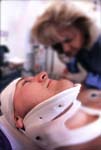“Doc, my head hurts!”
Every emergency room doctor hears these works every time they work. Although most headaches are no more than just that, a headache, the rare headache that is more can be a medical catastrophe for the patient, their family and their doctor. Doctors are expected to consider and eliminate the causes of headache that could be dangerous, but headache patients want their pain taken away.
What’s in the Doctor’s Head
Every doctor, from their medical school days, is taught to fear headaches that belie a fatal condition. Doctors are conditioned to interpret every severe headache as a possible ruptured aneurysm and nothing defines a headache as severe like the willingness to wait for hours in an ER waiting room.
Once doctors are in practice, they encounter the patients that they fear even more than those with bleeding in their brains. Patients seeking one form of secondary gain or another (attention, narcotic medications, time off work) visit emergency rooms because discovery of their motives is less likely because there is no continuity of care. Each ER visit is a different doctor and a new chart.
Over time, headache becomes associated in the mind of the ER doctor with skullduggery. This places the doctor in a quandary, torn between the concern for serious disease (aneurysm) and suspicion over motives fro coming to the emergency room at all.
What’s in the Patient’s Head
Over the years, many theories have been posited for what causes headache and migraine. The most current science indicates that headache and migraine are most often caused by activation of an area of the brain referred to as the “migraine generator.” This area exists in both the left and right side of the brain near the trigeminal ganglia. A headache can occur when either or both “generators” are active. The “migraine generator” creates chaotic signals causing pain.
What if it is not a simple headache or migraine? Serious causes of headache include not only aneurysm, but infection and injury. Aneurysms leak blood intermittently (sentinel bleeds) which are a form of warning headache. Eventually the aneurysm ruptures and bleeds into the brain. When this occurs, the headache is commonly described as the worst headache of the patient’s life. Headaches from bleeding aneurysms begin so suddenly, they are known as “thunderclap” headaches.
Infections such as meningitis and encephalitis are serious and life threatening contagious diseases that cause not only headache but fever, stiff neck and sometimes even a rash. These infections are so contagious that when suspected, everyone exposed to the patient is placed on antibiotics to prevent additional infections from occurring.
The emergency room doctor discovers these serious causes for headache with a combination of medical history (questions), CT scans of the brain and spinal tap. Many patients fear and even refuse the spinal tap because it involves a needle in the back, but even the best medical history and CT scans can only find 87% of the serious and fatal causes of headache. Spinal tap brings this to over 99%.
How Best to Get Rid of the Pain
The goal of going to the ER for a headache is to relieve the pain, but the treatment that patients most want (even demand) is the treatment most likely to cause another headache. Studies over the past three decades have demonstrated that narcotic pain medication (morphine, meperidine, butabutol, codeine, etc) and even non-narcotic pain medication (acetaminophen, aspirin, ketorolac, etc) cause “rebound headache.”
So how should a headache be treated?
The International Headache Society (IHS) is the professional organization dedicated to the study of the treatment of headache. IHS has published guidelines for headache based on the type of headache treated. Unfortunately it is often difficult or impossible, in a single ER visit, to narrow the diagnosis as tightly as the IHS guidelines would like. Instead, the enlightened ER doctor uses a combination of the first choice recommendations for headache and migraine from each broad category of headache. The combination looks like this:
First Medications (one of the following):
- Tryptan Medications (Imitrex, Maxalt, etc)
- Prochlorperazine (Compazine)
- Metoclopramide (Reglan)
Adjunct Treatments (both):
- Supplemental Oxygen
- Intravenous Fluids
But Doc My Head Hurts
When the headache is severe, worse of life and/or thunderclap in onset, patients going to the emergency room seek to ensure their own health and have pain relieved. Most headaches and migraines respond well to the IHS guideline treatments, but on rare occasions, true headache and migraine are resistant to these therapies. In these rare cases, the IHS guidelines state that conservative narcotic pain medication as “rescue therapy” is acceptable. Given these guidelines, this narcotic prescription should never be the first, second or even third treatment option chosen and when considered, the patient should receive full disclosure of the likelihood of rebound headache.
The decision to resort to narcotic pain medication in headache and migraine is a clinical decision. The incidence of migraine in the general population is far less than the incidence of headache and migraine as a presenting emergency room complaint. Given adequate conservative therapy, the prudent emergency room physician may opt to reserve further therapy given symptoms out of proportion to complaint, patient resistance to adequate evaluation and other factors. Conversely, the prudent emergency room physician may opt to employ rescue therapy despite limited clinical information.
Regardless of the patient presentation and clinical situation, headache and migraine will remain one of the best tests of the physician’s ability to meld the art and the science of medicine.










